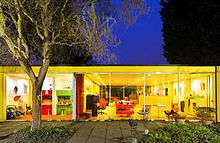22 Parkside

Coordinates: 51°25′35.86″N 0°13′19.56″W / 51.4266278°N 0.2221000°W Dr. Rogers House (or 22 Parkside) is a residential property in Wimbledon, London, designed in 1967 by British architect Richard Rogers and his then wife, Su, and built in 1968–70.[1][2][3] The house is located at 22 Parkside, Wimbledon, south-west London, and overlooks Wimbledon Common.[4] Since 22 February 2013, it has been a Grade II* listed building.[3]
Introduction
Parkside is a single-storey house designed in 1967 for Rogers' parents by Rogers and his then wife, Su. Set in a narrow plot of woodland just opposite Wimbledon Common, the house was built in 1968–70.[1][2][3] It is an notable early example of Rogers' work.[5] The house has remained in use by members of Rogers' family since its construction.[4] The house was put on the market in July 2013.[6]
A house situated in Feock, Cornwall designed by Rogers for his parents in-law and constructed 1964–67 achieved Grade II listing in 1998 and was upgraded to Grade II* status in 2002.[3][5]
Design
The Modernist style house makes extensive use of steel and glass, and is separated into two parts. The first part is a flat and pottery studio for Rogers' mother, with the main house set in trees behind.[2]
Configured as a 3-bedroom house, the design of the main house was presented to 1967 Paris Biennale as an example of British architecture. Its interior is open with flexible partitions that would allow for the creation of another rooms.[6] Day space includes a large open-plan kitchen, living room and dining room. There are a master bedroom, two small bedrooms, a bathroom and utility room. Two opposite sides of the house, north-east and south-west, have ceiling-to-wall glass with views onto the grounds, which consist of a courtyard and landscaped gardens.[3][6] The roof is flat and covered in felt.[3] Rogers himself believes this to be among the best example of his early work.[4][5] Rogers said that the approach he used to design this early work, such as the use of prefabricated steel and glass modules, served as an inspiration for much of his future work, which includes the Centre Georges Pompidou, co-designed with Renzo Piano, and the Grade I listed Lloyd's building.[5][6]
In listing it, English Heritage gave four reasons: its architectural and structural interest, historic interest, experimental use of materials and techniques and its intactness. Architecturally, they called it "an early, executed example of a High-Tech, steel-framed house in Britain" commenting on the significance of "prefabricated components" and "neoprene gaskets". Historically, they described it as "an important early work by a very significant architectural practice", and "a highly significant, surviving early British High-Tech building".[3]
WIth regard to material and techniques, English Heritage cited the use of "factory-finished components and dry construction", the "lightness and precision of steel", allowing "clear spans required for open-plan living and flexibility". As for intactness, it was noted that "the intention, structure and main built-in fittings are clearly legible, alongside later modifications, an endorsement of its versatility."[3]
References
- 1 2 Irving 2012, p. 559
- 1 2 3 Beth Dunlop (1999). A House for My Mother: Architects Build for Their Families. Princeton Architectural Press. pp. 14–. ISBN 978-1-56898-173-4.
- 1 2 3 4 5 6 7 8 "22 Parkside". English Heritage list. English Heritage. Retrieved 2 December 2013.
- 1 2 3 Tse, Samantha. "Private House Designed By Richard Rogers Receives Grade II Listing". BlouinArtinfo.com. Retrieved 7 December 2013.
- 1 2 3 4 Kenneddy, Maev. "House designed by Lord Rogers for his parents given Grade II* listing". The Guardian. Retrieved 2 December 2013.
- 1 2 3 4 Enoch, Nick (23 July 2013). "Three-bed house for £3.2m? Well, it did inspire the Pompidou centre: 1960s' home that architect Lord Rogers designed for his parents goes on sale for first time". Daily Mail. London. Retrieved 7 December 2013.
- Irving, Mark (2012). 1001 Houses You Must See Before You Die. London: Cassell Illustrated. ISBN 978-1-84403-738-4.